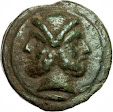Bronze steelyard weight
I am not
an expert on cast bronze statues, but I find several similar examples when I
search the internet for: Bronze Byzantine
Empress Steelyard Weight. A list of similar weights is given below1.
I am also not an expert on Women’s fashion during the late Roman and early
Byzantine period. I did find a web site that describes women’s fashons2.
With the
two qualifiers above, my description of the statue:
Steelyard
scale in the form of a late Roman or early Byzantine empress. Most of the
attributions call the empress anonymous. Byzantine empresses were
used for weights to encourage the public's belief the state ensured fair and
prosperous trade. She is
wearing a tunic (a bit like a T-shirt) that is covered by a Stola (Shawl, Himation,
Cloak, Toga or some sort of
outer garment.). The tunic drapes from her left shoulder to her right hip and
from her right shoulder under her right arm. Her right hand is open in the
center of her chest. In her left hand she holds a mappa, an
official symbol of imperial authority, or a scroll, reflecting the state's
emphasis on learning. Her jewelry is:
· A beaded necklace
· A second necklace (this might be jewels at the top of her toga).
· A crown with strings of jewels cascading down the right and left side of her face.
· A beaded necklace
· A second necklace (this might be jewels at the top of her toga).
· A crown with strings of jewels cascading down the right and left side of her face.
Her hair is braided in two strands and rolled to the top of
her head, see pic below3. It is hard to tell what is hair and what
is jewelry on this statue.
Dimensions:
·
8-1/8” tall (7-1/4” empress plus 1” hanging
ring)
·
4.25” wide; Some of the base has been bent due
to being dropped and is a bit wider.
·
3.0” thick
·
Oval base. Some weights have a circular or
irregular shape.
Weight:
·
1411 grams = 3.1 US pounds = 4.5 Roman pounds
(As or Libra)
Materials:
·
Cast bronze shell. Most catalogers say produced
by lost wax method, followed by cold working.
·
Some, but not this one, are filled with lead to
increase their weight.
1. Similar
examples I have found on line.
a. The
Metropolitan Museum of Art
NYC has three
b.
The MFA, Boston has one
c.
Harvard University has one
d.
The MFA Budapest has one
e.
The Research Library
at Dumberton Oaks has one
f.
Baltimore Museum of Art, Baltimore has one
g.
Cyprus Medieval
Museum
h.
ebyzantinemuseum
i.
Christies
2. Info
on Byzantine women’s dress.
3. Hairstyle
similar to Roman / Byzantine women.
4. I found some women on Byzantine coins on acsearch. There were no exact matches to my weight.
Aelia Flaccilla 383AD
Aelia Pulcheria 414AD
Aelia Pulcheria sister of Theodosius II 414AD
Aelia Verina 471AD
Eudoxia 395AD
Fausta 324AD
Licinia Eudoxia wife of Valentinian III 439
Aelia Flaccilla 379AD



























No comments:
Post a Comment